Human Eye and Colourful World
Class-10-CBSE-NCERT-Science-Chapter-10
Notes
|
Topics to be learn :
|
The Human Eye:
- It is most important and sensitive sense organ.
Structure of the eye:
As shown in Fig. the main parts of the human eye are as follows:
(i) Sclerotic: The eyeball is nearly spherical in shape with a diameter of about 2.3 cm. It has a tough and opaque white covering, called sclerotic.
- Functions : It protects and holds the eye.
(ii) Cornea: It is a thin membrane in front of the eyeball through which light enters the eye.
(iii) Choroid: It is a black membrane below the sclerotic.
- Functions : It absorbs straight light and avoids any blurring of image due to multiple reflections in the eyeball.
(iv) Iris and Pupil: Behind the cornea, there is an opaque circular diaphragm called iris. The colour of the iris determines the colour of the eyes of a person. The iris has a central hole called the pupil. Due to its muscular action, the iris controls the size of the pupil.
- Functions : Pupil regulates the amount of light entering the eye. In bright light, the pupil becomes small. In dim light, the pupil opens up completely through the relaxation of the iris.
(v) Eye lens: It is a double convex lens situated behind the iris. It is composed of a fibrous, jelly like material. The lens is held in position by suspensory ligaments and connected to the sclerotic by the ciliary muscles.
- Functions : By contracting or relaxing, the ciliary muscles can change the shape or curvature of the eye lens and hence change its focal length. This ability of the eye lens to change its focal length is called accommodation.
- This enables the eye lens to focus the images of objects at different distances on the retina of the eye.
- When the ciliary muscles of the eye are in their most relaxed state, the eye length is thin and its focal length is maximum.
(v) Retina: It is a delicate inner membrane on the back wall of the eyeball. It contains light sensitive cells called rods and cones. Rods are sensitive to intensity of light while cones are sensitive to colours.
- Functions : These cells change light energy into electrical signals which send message to the brain via the optic nerves.
(vi) Blind spot and yellow spot: In the region where the optic nerve enters the eyeball, there are no rods and cones. This region is totally insensitive to light-and is called blind spot. Yellow spot has maximum concentration of light sensitive cells. It is situated in the centre of the retina.
(vii) Aqueous humour and vitreous humour: Aqueous humour is a salty fluid (n = 1.337) that fills the space between the cornea and the eye lens. Vitreous humour is a jelly like fluid (n = 1.437) that fills the space between the retina and the eye lens.
Focusing action of the eye:
- The transparent structures like cornea, aqueous humour, eye lens and vitreous humour together constitute a single converging lens.
- As the rays from an object enter the eye, they suffer refractions on passing successively through these structures and get converged. A real and inverted image is formed on the retina.
- The light sensitive cells of retina get activated and generate electrical signals that are sent to the brain through the optic nerves. Our brain translates the inverted image into an erect image.
Power of Accommodation :
Accommodation is the ability or property of the eye lens due to which it can change its curvature or focal length so that images of objects at various distances can be formed on the same retina. The focal length of the eye lens is automatically changed with the help of ciliary muscles as follows:
(i) Viewing far off objects: When the ciliary muscles are completely relaxed, the eye lens is thin and its focal length is maximum (equal to distance between eye lens and retina). The rays coming from the distant object are parallel to each other and they are focused at the retina as shown in Fig. (a).
(ii) Viewing nearby objects: When we look at a nearby object, the ciliary muscles
contract, the eye lens bulges out and becomes thick and its focal length is reduced. This focuses the light from the nearby object on the retina, as shown in Fig. (b).
Range of vision:
- (i) Range of normal vision: Due to accommodation property of the lens, a normal eye can clearly see the objects situated anywhere between infinity and 25 cm from At distance less than 25 cm, the ciliary muscles cannot bulge the eye lens any more, the object cannot be focused on the retina and it appears blurred to the eye, as shown in Fig. The distance between infinity and 25 cm point is called the range of normal vision.
- (ii) Least distance of distinct vision (Near Point) : The minimum distance from the eye, at which the eye can see the objects clearly and distinctly without any strain is called the least distance of distinct vision or near point. It is denoted by the letter D. For a normal eye, its value is 25 cm.
- (iii) Far point: The farthest point from the eye, at which an object can be seen clearly by the eye is called the far point of the eye. For a normal eye, the far point is at infinity.
- (iv) Power of accommodation: The power of accommodation of the eye is the maximum variation of its power for focusing on near and far (distant) objects. For a normal eye, the power of accommodation is about four dioptres.
Cataract: In old age, the crystalline lens of some people becomes hazy or even
opaque due to the development of membrane over it. This condition is called cataract.
- This causes a decrease or loss of vision of the eye.
- The vision can be restored after getting cataract surgery.
Defects of vision and their correction :
Defects of vision: A normal eye can see objects clearly at any distance between
25 cm and infinity from the eye. Sometimes, a human eye gradually loses its power of accommodation. Then we cannot see the objects clearly. Our vision becomes defective. There are mainly four common defects of vision which can be corrected by the use of suitable eye glasses. These defects are:
- Myopia or near-sightedness
- Hypermetropia or far-sightedness.
- Presbyopia
(i) Myopia or short-sightedness: It is a vision defect in which a person can see
nearby objects clearly but cannot see the distant objects clearly beyond a certain point. This defect is common among children.
Cause of myopia: This defect arises due to either of the following two reasons:
- The eyeball gets elongated along its axis so that the distance between the eye lens and the retina becomes larger.
- The focal length of the eye lens becomes too short due to the excessive curvature of cornea.
As a result of the above causes, the parallel rays coming from a distant object do not meet at the retina but at a point in front of the retina, as shown in Fig. (a) and the distant object is not seen clearly. The object has to be moved closer to the eye to a point F to focus it on the retina, as shown in Fig. (b). Thus, the far point of a myopic eye is not at infinity but only a few metres from the eye.
Correction of Myopia: A myopic eye is corrected by using a concave lens of focal length equal to the distance of the far point F from the eye. This lens diverges the parallel rays from distant object as if they are coming from the far point F. Finally, the eye lens forms a clear image at the retina.
Calculation of focal length and power of correcting lens in myopia:
Let x be the distance of the actual far point from the eye and hence from the concave lens placed close to the eye. The rays coming from infinity, after refraction through the concave lens, appear to come from the far point F.
∴ u = − ∞, v = −x, f = ?
By lens formula,
\(\frac{1}{f}=\frac{1}{v}-\frac{1}{u}\) = \(\frac{1}{-x}-\frac{1}{−∞}\) = \(-\frac{1}{x}\) + 0 = \(-\frac{1}{x}\)
∴ Required focal length, f = − x
Required power, P = \(\frac{1}{f}=-\frac{1}{x}\)
The negative sign shows that the correcting lens is a concave lens.
(ii) Hypermetropia or long-sightedness: It is a vision defect in which a person can see the distant objects clearly but cannot see the nearby objects clearly.
Cause of hypermetropia: This defect arises due to either of the following two reasons:
- The eyeball becomes too small along its axis so that the distance between the eye lens and the retina is reduced.
- The focal length of the eye lens becomes too large resulting in the low converging power of the eye lens.
As a result of the above causes, the rays coming from an object placed at 25 cm (normal near point) from the eye meet at a point behind the retina, as shown in Fig. (a). So the object is not seen clearly.
To focus the rays again on the retina, the object has to be moved away from the eyes to a distance greater than 25 cm, as shown in Fig. (b). Thus, the near point of the eye is not at 25 cm but it has shifted to N’ at a distance greater than 25 cm from the eyes.
Correction of hypermetropia: A hypermetropic eye is corrected by using a convex lens of suitable focal length. This lens diverges the rays such that the rays coming from normal near point N appear to come after refraction, from near point N’ of the defected eye. That is a virtual image of the object placed at N is formed at N’. Then the eye lens forms a clear image at the retina, as shown in Fig.(c).
Calculation of focal length and power of correcting lens in hypermetropia:
Refer to Fig. (c). Let y = distance of the near point N’ from the defective eye.
Now the near point N of the normal eye is at distance D = 25 cm.
The object placed at N forms its virtual image at N’ due to the convex lens.
∴ u = − D, v = −y, f = ?
By lens formula,
\(\frac{1}{f}=\frac{1}{v}-\frac{1}{u}\) = \(\frac{1}{-y}-\frac{1}{−D}\) = \(\frac{y-D}{yD}\)
∴ Required focal length, f = \(\frac{yD}{y-D}\)
Required power, P = \(\frac{1}{f}=\frac{y-D}{yD}\)
As y > D, so both f and D are positive. That is the correcting lens must be a convex lens.
(iii) Presbyopia:
- This defect is similar to hypermetropia i.e., a person having this defect cannot see nearby objects distinctly, but can see distant objects without any difficulty.
- It usually occurs in elderly persons. Due to the stiffening of the ciliary muscles, the eye lens loses flexibility and hence the accommodating power of the eye lens decreases.
- This defect differs from hypermetropia in the cause by which it is produced.
Know This : Some people suffer from both myopia and hypermetropia. Such people require bifocal lenses. The upper part of the bi-focal lens is a concave lens used for distant vision while its lower part is a convex lens used for reading purposes.
These days, refractive defects are also corrected by using contact lenses or through surgical interventions.
(iv) Astigmatism: It is a defect of vision in which a person cannot simultaneously see both the horizontal and vertical views of an object with the same clarity.
Cause of astigmatism:
- This defect occurs when the cornea of the eye is not perfectly spherical.
- This results in objects in one direction being well-focused while those in perpendicular direction are not well-focused.
Correction of astigmatism: Astigmatism can be corrected by using cylindrical lenses. They have different curvatures in horizontal and vertical directions and so they can be oriented suitably to compensate for the irregularities in the cornea, as shown in below above Fig.
(v) Colour-blindness : It is a defect of vision in which a person cannot distinguish between various colours but can see well otherwise.
- Cause of colour blindness : It is due to absence of some cones in the retina of the eye.
Refraction of light through a prism :
Prism:
A prism is a portion of a transparent medium bounded by two plane faces inclined to each other at a certain angle.
Consider a triangular glass prism. It has two triangular bases and three rectangular lateral surfaces. These surfaces are inclined to each other. The angle between its two lateral faces is called the angle of the prism.
- The two plane faces ABED and ACFD inclined to each other are called refracting faces of the prism.
- The line AD along which the two refracting faces meet is called refracting edge of the prism.
- The face BCFE opposite to the refracting edge is called base of the prism.
- The angle A at which the two refracting faces are inclined to each other is called angle of the prism.
- A section ABC made by a plane at right angles to the refracting edge is called principal section of the prism.
Refraction through a glass prism: Fig. shows the principal section ABC of a glass prism.
- A ray PQ is incident on face AB. As it enters the denser medium (glass), it bends away from the normal along path QR.
- The ray QR again suffers refraction at face AC; bending away from the normal, it emerges along RS.
- The angle D between the incident ray and the emergent ray is called the angle of deviation.
- The angle e made by the emergent ray with the normal to the refracting face AC is called the angle of emergence.
- Clearly, a light ray bends towards the base of the prism as it suffers refraction through the prism. It is seen that, i + e = A + D.
- In other words, Angle of incidence + Angle of emergence = Angle of prism + Angle of deviation
Dispersion of white light by a glass prism :
Dispersion of light: The phenomenon of splitting of white light into its component colours on passing through a refracting medium such as a glass prism is called dispersion of light. The pattern of the coloured bands obtained on the screen is called spectrum. Sir Isaac Newton was the first to use a glass prism to obtain the spectrum of sunlight.
- When a narrow beam of white light (sunlight or torch light) is passed through a triangular glass prism, it splits into a band of seven colours, as shown in
- The seven colours are in the order violet, indigo, blue, green, yellow, orange and
- The red colour is deviated the least while the violet colour is deviated the most. The colour sequence can be remembered by the acronym VIBGYOR.
Cause of dispersion of white light:
- Light rays of different colours travel with the same speed in vacuum. But in refracting media like glass, water, etc., lights of different colours travel with different speeds.
- The speed of violet colour is the least while the speed of red colour is the largest in glass.
- As a result, the refractive index of glass is largest for violet colour and least for red colour. The violet colour is deviated most while the red colour is deviated least on passing through the prism.
- Other colours are deviated by intermediate angles. So, different component colours of white light get dispersed on passing through a glass prism.
Recombination of seven colours to form white light:
- As shown in below Fig. take two identical prisms P1 and P2. Keep the second prism P2 upside down with respect to the first prism.
- Allow a narrow beam of white light to fall on first prism P1.
- The first prism P1 disperses the white light into seven colours. The second prism P2 receives these seven colours and recombines them into white light.
- Thus a beam of white light emerges from the other side of the second prism.
This observation gave Newton the idea that the sunlight is made of seven colours.
Any light that gives a spectrum similar to that of sunlight is called white light.
Glass prism v/s glass slab : In a glass slab, both the refracting faces are parallel. All the emergent rays are parallel to the incident rays. Hence there is neither dispersion nor any deviation of light. Therefore glass slab does not produce any spectrum.
Rainbow: A rainbow is a natural spectrum appearing in the sky after a rain shower
- It is caused by dispersion of sunlight by tiny water droplets, present in the atmosphere.
- A rainbow is always formed in a direction opposite to that of the Sun.
- The water droplets act like small prisms. They refract and disperse the incident
- sunlight, then reflect it internally, and finally refract it again when it comes out of the raindrop (Fig.).
- Due to the dispersion of light and internal reflection, different colours reach the observer’s eye.
- We can also see a rainbow on a sunny day when we look at the sky through a waterfall or through a water fountain, with the Sun behind us.
Atmospheric refraction :
- Due to atmospheric refraction i.e., refraction of light by the earth’s
- The air just above the fire becomes hotter than air further up. Hotter air is lighter (less denser) than the cooler air (denser) above it.
- This causes refraction of light due to decrease of refractive index with decreasing density or increasing temperature.
- Since the physical conditions of the refracting medium (air) are not stationary, the apparent positions of the objects, as seen through the hot air, fluctuate. Consequently, the objects seen through such air show a wavering effect.
Twinkling of stars :
Due to variations in the atmospheric conditions, the apparent position of the star keeps on changing and also the amount of light coming from that star changes randomly with time. This gives rise to twinkling effect of the star.
The planets do not show twinkling effect: As the planets are much closer to the earth, the amount of light received from them is much greater and the fluctuations caused in the amount of light due to atmospheric refraction are negligible as compared to the amount of light received from them.
Advance sunrise and delayed sunset :
Apparent shift in the position of sun at sunrise and sunset:
- The sun is visible before actual sunrise and after actual sunset, because of atmospheric refraction. With altitude, the density and hence refractive index of air-layer decreases.
- As shown in above Fig (b), the light rays starting from the sun travel from rarer to denser layers. They Apparent bend more and more towards the normal.
- To an observer on the earth, light rays appear to come from position S’. The sun which is actually in position S below the horizon, appears in position S’ above the horizon.
- Thus the sun appears to rise early by about two minutes and for the same reason, it appears to set late by about two minutes. This increases the length of the day by about four minutes.
Apparent flattening of the sun’s disc at sunrise and sunset:
- This is due to atmospheric refraction. The density and the refractive index of the atmosphere decreases with altitude, so the rays from the top and bottom portion of the sun on the horizon are refracted by different degrees. This causes the apparent flattening of the sun.
- But the rays from the sides of the sun on a horizontal plane are generally refracted by the same amount, so the sun still appears circular along its sides.
Scattering of light
Scattering of light: It is the phenomenon in which a part of light incident on a particle is redirected in different directions.
Colloids:
- A colloid is an intermediate state of true solution and suspension.
- A colloid is a heterogeneous system in which one substance is dispersed (disperse phase) as very fine particles in another substance called dispersion medium.
- Colloidal particles have sizes between 1 and 1000 nm (10-9 to 10-6 m).
- For example, in milk, water is dispersion medium while fats, proteins etc., constitute disperse phase.
Properties of colloidal solutions:
- They are heterogeneous mixtures.
- The size of the colloidal particles ranges between 1 nm to 1000 nm.
- The path of a beam of light becomes visible while passing through a colloidal solution (Tyndall effect).
- Colloidal particles cannot be separated by simple sedimentation or filtration.
Tyndal effect:
- When a beam of light is passed through a colloidal solution, placed in a dark room, the path of beam becomes illuminated (or visible), when observed through a microscope placed perpendicular to the path of light. This effect is called Tyndall effect.
- On the other hand, the path of a beam of light is not visible through a true solution, as shown in below Fig.
Cause of Tyndall effect: The size of the colloidal particle is relatively larger than the solute particle of a true solution. The colloidal particles first absorb energy from the incident light and then scatter a part of this energy from their surfaces. Thus Tyndall effect is due to scattering of light by the colloidal particles and the colloidal particles are seen as points of light moving against a dark background.
Some daily life phenomena based on Tyndall effect :
- When a fine beam of sunlight enters a smoke filled room through a small hole, the smoke particles become visible due to the scattering of light.
- When sunlight passes through a canopy of a dense forest, the tiny water droplets in the mist scatter light and become visible.
Colour of the scattered light :
- The colour of the scattered light depends on the size of the scattering particles.
- Very fine particles having sizes less than the wavelength of visible light mainly scatter blue light of shorter wavelength of the visible spectrum.
- The particles of relatively larger size scatter light of longer wavelengths.
Examples :
- The large particles like raindrops, dust and ice particles scatter white light.
- The sky appears dark from the surface of the moon because there are no atmospheric particles to scatter sunlight.
- The water molecules of the ocean scatter blue light more strongly than light of other colours. So the ocean appears bluish.
- Traffic light/Danger signal in red colour : In the visible spectrum, the red colour has the largest wavelength. The red colour is least scattered by fog or dust particles. So we can observe red colour easily even in foggy and dusty conditions.
Why is the colour of the clear Sky Blue?
- The molecules of air and other fine particles in the atmosphere have size smaller than the wavelength of visible light.
- These are more effective in scattering light of shorter wavelengths at the blue end than light of longer wavelengths at the red end.
- The red light has a wavelength about 1.8 times greater than blue light.
- Thus, when sunlight passes through the atmosphere, the fine particles in air scatter the blue colour (shorter wavelengths) more strongly than red.
- When we look at the sky, the scattered light enters our eyes and this light contains blue light in a larger proportion. That is why, the sky appears blue.
Redishness at sunset and sunrise:
- When the sun is near horizon at sunset or sunrise, the light rays have to pass through a larger thickness of the atmosphere than when the sun is overhead at noon, as shown in Fig.
- Consequently, the lower wavelengths in the blue region are almost completely scattered away by the air molecules.
- The higher wavelengths of the red region are least scattered and reach our eyes. Hence, the sun appears almost reddish at sunset or sunrise.
- This phenomenon is not observed on the moon. There are no atmospheric particles to scatter light.
Colour of sky in the absence of atmosphere : In the absence of any atmosphere, there will be no scattering of sunlight and the sky will appear dark. The sky appears dark to passengers or astronauts flying at high altitudes, as scattering is not prominent at such heights due to thin atmosphere.
Click on below links to get PDF from store
PDF : Class 10th-Science-Chapter-10-Human Eye and Colourful World-Notes
PDF : Class 10th-Science-Chapter-10-Human Eye and Colourful World-Solution
All Chapters Class-10-Science-NCERT- Notes set (13-PDF) Rs.73
All Chapters Class-10-Science NCERT-Solution set (13-PDF) Rs.55
All Chapters Class-10-Science-NCERT- Notes & Solutions set (26-PDF) Rs.105
Main Page : NCERT-Class-10-Science – All chapters notes, solutions, videos, test, pdf.
Previous Chapter : Chapter 9-Light – Reflection and Refraction – Online Notes
Next Chapter : Chapter-11-Electricity – Online Notes
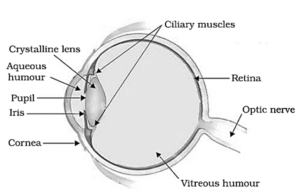

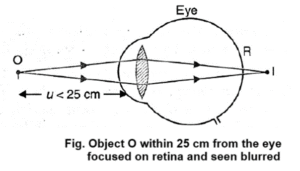

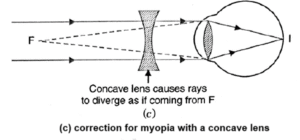

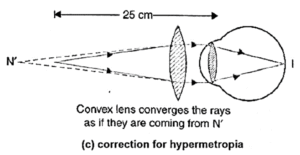
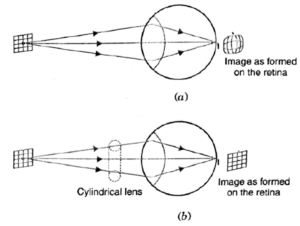
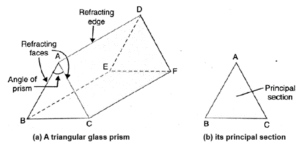
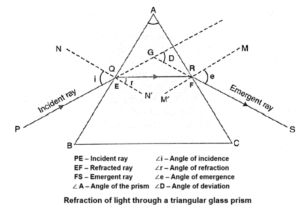
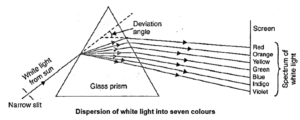
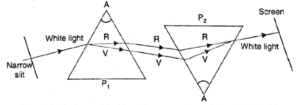
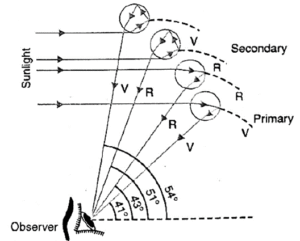

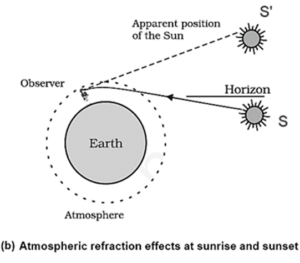
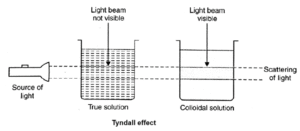
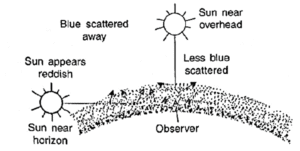
We reply to valid query.